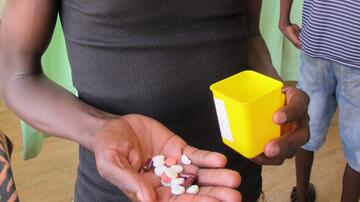Prevention of tuberculosis: When should contact persons receive preventive treatment?
Electron micrograph of Mycobacterium tuberculosis.
In a large-scale systematic review, researchers from an international consortium analysed more than 25,000 publications from the last 20 years. They examined the circumstances under which contact persons of tuberculosis (TB) sufferers benefit from receiving preventive antibiotic therapy so that they do not fall ill themselves. The result showed that the effective strategy depends on the TB incidence of the country: in low-incidence countries, it makes sense to give preventive treatment only to those contact persons for whom a skin test or blood test shows evidence of contact with tuberculosis bacteria. In high-incidence countries, all close contacts of people with tuberculosis should receive preventive treatment if no tests are available.
Mycobacterium tuberculosis, the causative agent of tuberculosis, is transmitted from person to person via droplets. People suffering from pulmonary tuberculosis excrete the pathogens when coughing and sneezing, which can then be inhaled by contact persons. In order to prevent the spread of tuberculosis, it is not only important to isolate and treat the infected person immediately, but also to identify and test close contacts in the patient's vicinity.
Special immunological tests can be used to determine whether a person has already been infected with tuberculosis bacteria. These tests cannot detect the infection itself, but provide indirect information on whether immune cells have been formed in the body that are directed against tuberculosis bacteria or individual components of the tuberculosis bacteria. The most commonly used tests are the tuberculin skin test and the so-called interferon-gamma release assays (IGRA).
If it is suspected that you have been infected as a close contact person or if an immune test is positive, preventive treatment can be initiated. This prophylactic administration of antibiotics can be very useful in preventing a disease—however, due to the duration and side effects, it is not always advisable. It is assumed that one in four people worldwide carries the TB pathogen without contracting the disease. Groups at risk of developing active pulmonary tuberculosis include young children, immunocompromised people and people from countries where tuberculosis is common.
In order to evaluate the effectiveness of preventive tuberculosis treatment in exposed persons of different ages and infection status with Mycobacterium tuberculosis—taking into account the tuberculosis burden in the environment—an international research team led by Prof. Christoph Lange, Medical Director at the Research Center Borstel, Leibniz Lung Center, analysed over 25,000 research publications from the last 20 years, including studies on a total of 430,000 persons affected by tuberculosis. The study also took into account how many contact persons needed to be treated in order to prevent the disease. The study has now been published in the renowned journal Lancet Respiratory Medicine.
"Throuhg this work, we wanted to obtain robust data on which individuals benefit most from preventive tuberculosis treatment and whether this benefit differs in countries with high and low exposure of the population to tuberculosis bacteria," explains Prof Lange, senior author of the study and scientist in the "Tuberculosis" research area of the German Center for Infection Research (DZIF).
"The result is clear!" summarises Christoph Lange. "In countries with a low incidence, you have to test and should only treat those contact persons who have a positive test result. In recent years, we have been able to show that blood tests are a better indicator of the risk of tuberculosis than skin tests. However, neither type of test is particularly good at predicting the future risk of developing tuberculosis. The situation is different in high-incidence countries. There it makes no difference whether the test result—whether blood test or skin test—is positive or not, all contact persons should be treated."
"As preventive antibiotic therapy is very effective, it should be used much more, especially in high-incidence countries," says Prof Lange. "Until we have a better vaccine to protect against tuberculosis, preventive antibiotic treatment of contact persons is one of the most effective measures to prevent the spread of tuberculosis."
Source: Press release of the Research Center Borstel, Leibniz Lung Center




